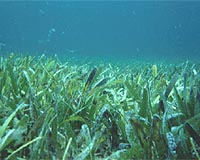| . |  |
. |
Moffett Field CA (SPX) Jul 07, 2009 Nickel, an important trace nutrient for the single cell organisms that produce methane, may be a useful isotopic marker to pinpoint the past origins of these methanogenic microbes, according to Penn State and University of Bristol, UK, researchers. "Our data suggest significant potential in nickel stable isotopes for identifying and quantifying methanogenesis on the early Earth," said Vyllinniskii Cameron, recent Penn State Ph.D. recipient in geosciences and astrobiology and currently a post-doctoral fellow at the University of Bristol. "Little is known about the actual timing of the evolution of methane-producing organisms or their metabolism. Nickel stable isotope fractionation may well prove to be the fundamental unambiguous trace metal biomarker for these methanogens." Fractionation of an element into its component stable isotopes occurs because each isotope is slightly different in mass. Biological organisms tend to favor one isotope over another and preferentially create stores of heavy or light isotopes that researchers can measure. The presence of a specific isotopic fraction can indicate that a biological process took place. Previous researchers have looked at transition metals other than nickel as potential biomarkers. "There is a lot of interest in iron and copper isotopes and other metals that microbes use in trace amounts," said Christopher H. House, associate professor of geosciences and director of the Penn State Astrobiology Research Center, part of the NASA Astrobiology Institute. "However, iron goes through oxidation reduction processes with or without a biological component, so there is significant complexity when it is used as a biosignature." In nature nickel does not seem to be as adversely affected by oxidation reduction changes so isotope fractionation might be more easily attributed to biological processes, such as during microbial assimilation or uptake of metals. For this work the researchers did not look at ancient fossil cells, but grew modern day archaea in the laboratory, controlling their habitat and recording their rate of methane production. Archaea are single cell microorganisms similar to bacteria but with different evolutionary histories and biochemical pathways. The researchers report their results in the June 22 online edition of the Proceedings of the National Academy of Sciences. Through a grant from the Worldwide Universities Network and a NASA research scholarship, Cameron performed the research, including setting up the protocols for the nickel isotopic system, at the University of Bristol with Derek Vance and Corey Archer, Bristol Isotope Group, department of Earth Sciences. Cameron first investigated samples representative of the Earth's mantle and crust that were without any biological activity. These samples showed very little variation in nickel isotopic composition. She also analyzed samples from a group of meteorites, which exhibited even less variation. These studies showed that non-biological processes do not significantly fractionate nickel isotopes. However, isotopic analyses of pure cultures of three archaea - Methanosarcina barkeri, Methanosarcina acetivorans and Methanococcus jannaschii - showed that all the archaea fractionated nickel so that the nickel component in the microbe was lighter relative to the starting isotopic value of the growth medium. To test whether non-methanogenic cells would also fractionate nickel, Cameron incubated an archaea that does not produce methane, Pyrobaculum calidifontis, under the same conditions. These cells did not fractionate nickel isotopes. "While we only tested one non-methanogen and a more diverse suite of microorganisms should be investigated, at this time, it appears that nickel isotopic fractionation produced by microorganisms in general will not be as significant as the fractionation produced by methanogenic archaea," said Cameron. "It may be possible in the future to test organic rich sedimentary layers from 2.7 billion years ago to see if nickel isotopic fractionation occurred," said House. "Because there are no known bacteria that are methanogenic and because archaea seem to fractionate nickel isotopes, perhaps such work can help pinpoint when these methane-producing organisms came into being." Share This Article With Planet Earth
Related Links Penn State Darwin Today At TerraDaily.com
 Loss Of Coastal Seagrass Habitat Accelerating Globally
Loss Of Coastal Seagrass Habitat Accelerating GloballyCambridge MD (SPX) Jul 07, 2009 An international team of scientists warns that accelerating losses of seagrasses across the globe threaten the immediate health and long-term sustainability of coastal ecosystems. The team has compiled and analyzed the first comprehensive global assessment of seagrass observations and found that 58 percent of world's seagrass meadows are currently declining. The assessment, published in ... read more |
|
| The content herein, unless otherwise known to be public domain, are Copyright 1995-2009 - SpaceDaily. AFP and UPI Wire Stories are copyright Agence France-Presse and United Press International. ESA Portal Reports are copyright European Space Agency. All NASA sourced material is public domain. Additional copyrights may apply in whole or part to other bona fide parties. Advertising does not imply endorsement,agreement or approval of any opinions, statements or information provided by SpaceDaily on any Web page published or hosted by SpaceDaily. Privacy Statement |